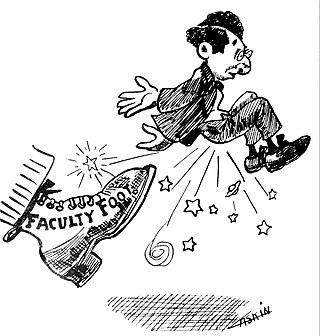Related Research Articles

A disease is a particular abnormal condition that adversely affects the structure or function of all or part of an organism and is not immediately due to any external injury. Diseases are often known to be medical conditions that are associated with specific signs and symptoms. A disease may be caused by external factors such as pathogens or by internal dysfunctions. For example, internal dysfunctions of the immune system can produce a variety of different diseases, including various forms of immunodeficiency, hypersensitivity, allergies, and autoimmune disorders.

Space adaptation syndrome (SAS) or space sickness is a condition experienced by as many as half of all space travelers during their adaptation to weightlessness once in orbit. It is the opposite of terrestrial motion sickness since it occurs when the environment and the person appear visually to be in motion relative to one another even though there is no corresponding sensation of bodily movement originating from the vestibular system.

Termination of employment or separation of employment is an employee's departure from a job and the end of an employee's duration with an employer. Termination may be voluntary on the employee's part (resignation), or it may be at the hands of the employer, often in the form of dismissal (firing) or a layoff. Dismissal or firing is usually thought to be the employee's fault, whereas a layoff is generally done for business reasons outside the employee's performance.

The FIFA Men's World Ranking is a ranking system for men's national teams in association football, led by Argentina as of April 2023. The teams of the men's member nations of FIFA, football's world governing body, are ranked based on their game results with the most successful teams being ranked highest. The rankings were introduced in December 1992, and eight teams have held the top position, of which Brazil have spent the longest ranked first.
Absenteeism is a habitual pattern of absence from a duty or obligation without good reason. Generally, absenteeism refers to unplanned absences. Absenteeism has been viewed as an indicator of poor individual performance, as well as a breach of an implicit contract between employee and employer. It is seen as a management problem, and framed in economic or quasi-economic terms. More recent scholarship seeks to understand absenteeism as an indicator of psychological, medical, or social adjustment to work.

University of Bradford School of Management is an international business school located in Bradford, West Yorkshire, England. It was established in 1963 and is one of the oldest business schools in the UK, celebrating its 60th anniversary in 2023. The school is triple accredited by AACSB, AMBA and EQUIS.
Presenteeism or working while sick is the act or culture of employees continuing to work as a performative measure, despite having reduced productivity levels or negative consequences. Reduced productivity during presenteeism is often due to illness, injury, exhaustion, or other conditions, but presenteeism can also describe working while contagiously sick, which has the added risk of creating a workplace epidemic.
Medical Care and Sickness Benefits Convention, 1969 is an International Labour Organization Convention. It was established in 1969 revised Convention C24 Sickness Insurance (Industry) Convention, 1927 and Convention C25 Sickness Insurance (Agriculture) Convention, 1927.
In human resources, turnover is the act of replacing an employee with a new employee. Partings between organizations and employees may consist of termination, retirement, death, interagency transfers, and resignations. An organization’s turnover is measured as a percentage rate, which is referred to as its turnover rate. Turnover rate is the percentage of employees in a workforce that leave during a certain period of time. Organizations and industries as a whole measure their turnover rate during a fiscal or calendar year.
Sick leave is paid time off from work that workers can use to stay home to address their health needs without losing pay. It differs from paid vacation time or time off work to deal with personal matters, because sick leave is intended for health-related purposes. Sick leave can include a mental health day and taking time away from work to go to a scheduled doctor's appointment. Some policies also allow paid sick time to be used to care for sick family members, or to address health and safety needs related to domestic violence or sexual assault. Menstrual leave is another type of time off work for a health-related reason, but it is not always paid.
The Bühlmann decompression set of parameters is an Haldanian mathematical model (algorithm) of the way in which inert gases enter and leave the human body as the ambient pressure changes. Versions are used to create Bühlmann decompression tables and in personal dive computers to compute no-decompression limits and decompression schedules for dives in real-time. These decompression tables allow divers to plan the depth and duration for dives and the required decompression stops.
Paid time off, planned time off, or personal time off (PTO), is a policy in some employee handbooks that provides a bank of hours in which the employer pools sick days, vacation days, and personal days that allows employees to use as the need or desire arises. This policy pertains mainly to the United States, where there are no federal legal requirements for a minimum number of paid vacation days. Instead, U.S. companies determine the amount of paid time off that will be allotted to employees, while keeping in mind the payoff in recruiting and retaining employees.
Base runs (BsR) is a baseball statistic invented by sabermetrician David Smyth to estimate the number of runs a team "should have" scored given their component offensive statistics, as well as the number of runs a hitter or pitcher creates or allows. It measures essentially the same thing as Bill James' runs created, but as sabermetrician Tom M. Tango points out, base runs models the reality of the run-scoring process "significantly better than any other run estimator".
Chacón Navas v Eurest Colectividades SA (2006) C-13/05 is an EU labour law case that sets forth a uniform definition of disability in the European Union. Both the Treaty of Amsterdam and the EU Framework Directive on Employment left open the definition of disability, which allowed the Court to adopt its own definition.
In workplaces, especially in Australia, a mental health day is where an employee takes sick leave, or where a student does not attend school for a day or longer, for reasons other than physical illness. Mental health days are believed to reduce absenteeism and presenteeism, which is a reduction in productivity or other negative consequences resulting from a pressure to work. Mental health days differ from absenteeism in that the purpose is to reset one's mental health rather than due to a nonspecific desire or feeling to skip work.
The World Archery Rankings is a ranking system developed by the World Archery Federation for international competitive archery. It is calculated using a points system and published following major World Archery tournaments.
Employee morale or workspace morale is the morale of employees in workspace environment. It is proven to have a direct effect on productivity.
Leaveism (leavism) is a term first coined in 2013 by Dr Ian Hesketh, a researcher at University of Manchester, to describe the phenomena of employees using flexitime, annual leave, rest days and other leave entitlement schemes to have time off when they are in fact too unwell to go to work. He later extended this to include occasions whereby employees took work home and/or on holiday that they could not complete in paid working hours. Hesketh's research, which centred on well-being in the UK police service, sought to identify a gap in current thinking around absenteeism and presenteeism; of which there is a plethora of academic study and commentary. The aim of his studies was to highlight that the true extent of sickness absence may be masked by the practice of leaveism, and that there may be a hidden populace experiencing significant work overload.
A human resources management system (HRMS) or Human Resources Information System (HRIS) or Human Capital Management (HCM) is a form of Human Resources (HR) software that combines a number of systems and processes to ensure the easy management of human resources, business processes and data. Human resources software is used by businesses to combine a number of necessary HR functions, such as storing employee data, managing payroll, recruitment, benefits administration, time and attendance, employee performance management, and tracking competency and training records.
Absence management, also known as leave management, is a combination of employer policies, procedures, or programs designed to handle employee leaves of absence and minimize the impact of those absences on the employer. Absence management programs aim to maximize productivity by supporting an employee from initial absence through return-to-work and stay-at-work plans.
References
- 1 2 O'Connor, Sarah (14 December 2020). "Punitive sick leave rules make us all pay". FT.com . Retrieved 12 July 2021.
- 1 2 Stroud, Sam (23 June 2021). "The Secretive Formula Used by Bosses to Punish Workers for Being Sick". Tribune . Retrieved 12 July 2021.
- ↑ "Absence measurement and management 27 April 2021" Archived 21 April 2021 at the Wayback Machine Retrieved 3 March 2022
- ↑ Duffy, Jonathan (2001-05-02). "Ill Wind Blowing for the Sickie". BBC News. Retrieved 2007-05-05.
- ↑ Cabinet Office (2004). "Managing Sickness Absence in the Public Sector" (PDF). UK government. p. 20. Archived from the original (PDF) on 2023-01-07. Retrieved 2007-05-07.
- ↑ Lindsay, Kali (5 October 2017). "What is the Bradford Factor and can you be sacked for being off sick too much?". ChronicleLive. Retrieved 17 December 2020.
- ↑ See The Bradford Factor: Are Bradford Scores the best way of calculating sickness absence rates? Occupational Health at Work, 2006 2(5) p28-29
- ↑ "Sickness Absence: the Bradford Factor" (PDF). Unison (trade union) . Retrieved 12 July 2021.